Christmas in India – An Insight Into how India Celebrates Christmas
India has always held Christmas in high regard. Though the population of Christians is just around 2.5% of the total population, India has around 30 million Christians distributed over various states and territories.
Christmas Celebrations in Various Parts of India:
Goa has a Christian population of around 25%, which makes Christmas in Goa a sight to behold. It is a known fact that Goans love to celebrate Christmas with much fervour. People participate in midnight masses and gorge on traditional curries and Christmas pies. People also decorate and maintain traditional Christmas trees which helps in bringing the spirit of Christmas alive.

Goans prepare a traditional delicacy, called “Neureos”, which you could try at home today!

Let’s go from the Westernmost corner of India to the Easternmost corner. India’s North East also has a very high concentration of Christians who take pride in celebrating Christmas with much enthusiasm. In the Northeast, tribal Christians celebrate their Christmas week by going out every night, singing their traditional Christmas carols and telling the villagers the story of Christmas. The whole state is beautifully lit to welcome the arrival of their dear Santa Claus, and the air is alive with singing and merriment.
In Kerala, Christmas is an important festival, for about 20-23% of the population is Christian. The huge churches of Cochin are majestically decorated to get the town in the spirit of Christmas – not that it is required, though. Keralites hold Christmas close to their hearts, as is evident by their exalted celebrations. Syrian Catholics are known to fast from the 1st to the 24th of December, and will break their fast only on the Christmas Eve Midnight Mass. The midnight mass sees an atmosphere of exuberance and excitement – Christmas is finally here.

Keralites take their Christmas food just as seriously as the festival itself. Here’s one of our favorites, Lemon-Garlic Herbs Grilled Chicken.
When talking about Christmas, one cannot ignore the decorous spirit of Mumbai in celebrating this festival. Mumbai’s public places are awash with Christmas lights and stores usually have a small Christmas tree up front. Christmas in Mumbai is much like Christmas in Australia – neither is it cold, nor is there any snow.
However, Mumbaikars celebrate Christmas with lots of enthusiasm. Here’s a list of a few Midnight Masses in Mumbai that you shouldn’t miss out on.
How Farmers Celebrate Christmas in India
India has a small number of Christian farmers. Most of them are marginal farmers who can barely make ends meet. However, this doesn’t stop most of them from getting into the spirit of Christmas. Sometimes, instead of a traditional Christmas tree, some people decorate Banyan or Mango trees, the reason being that they’re easily found and are significantly cheaper. For most Christian farmers, Christmas celebrations are all about affordability. Some will also use mango leaves to decorate their homes.
Fair Trade – How it Can Make Christmas Possible for Farmers, & What You Can Do:
‘Fair trade’ in agriculture simply means that the farmer gets sufficient monetary compensation for their efforts, rather than money being skimped off by middlemen and other intermediaries. Free trade involves a lot of local sourcing connections and can be difficult to establish in a system so fixated on middlemen.
It is a known fact that farmers are exploited six ways to Sunday by middlemen at every opportunity they get – and the opportunities are plenty. The result is that the farmer doesn’t get a fair compensation for all their hard work in tending to their crops.
Christmas is all about kindness and looking out for those around you. Farmers form a pretty significant part of our lives. Paying the farmers a fair price will only strengthen their resolve, helping you make their Christmas better.
Fair trade not only ensures the farmer a fair monetary compensation for their efforts, but also the respect that they so rightfully deserve.
What can you do to help farmers? For one, you could either start purchasing directly from local farmers without the added burden of middlemen, or buy from an organization that works closely with farmers to help these farmers make some money.
How You Can Go Organic This Christmas:
There are a quite a few things you could tweak this Christmas to go organic. Here are a few things you can readily implement this year:
1. Go for Seasonal, Organically Grown Veggies:
A lot of people host Christmas parties. The food you serve can be organic. Choose seasonal, organically grown vegetables to go into your menu as the bare minimum you can do to go organic.
2. Organic Cotton:
Cotton is regarded as one of the most polluting industries. Organic cotton, on the other hand is grown using sustainable farming practices. Indians use cotton for two purposes during Christmas – decorations and gifts.
Not all regions of India are blessed with snow during Christmas, resulting in widespread use of cotton to create the effect. The other use of cotton occurs in the form of gifts – a lot of people gift other people clothes during Christmas. Swapping for organically grown cotton will help reduce your carbon footprint, and help you go organic.
3. Identify Your Local Farmers:
This Christmas, ditch the supermarkets for your food-based needs. Identify your local farmers, locate their farms and try to spend at least a little time with them. This serves two purposes – one, you get to know the farmer and their hardships, and two, you get to help them by buying their produce directly.
The Bottom Line
Christmas has always been a big deal in India. Over the past few years, it has started gaining more popularity in terms of celebrations. You don’t necessarily have to be Christian to get into the Christmas spirit. It is rightfully said that Christmas isn’t just a festival – it’s a feeling.
Get into the Christmas spirit, take time off to be with your family and friends.
Daana wishes its customers a Merry Christmas, and a Happy New Year.



